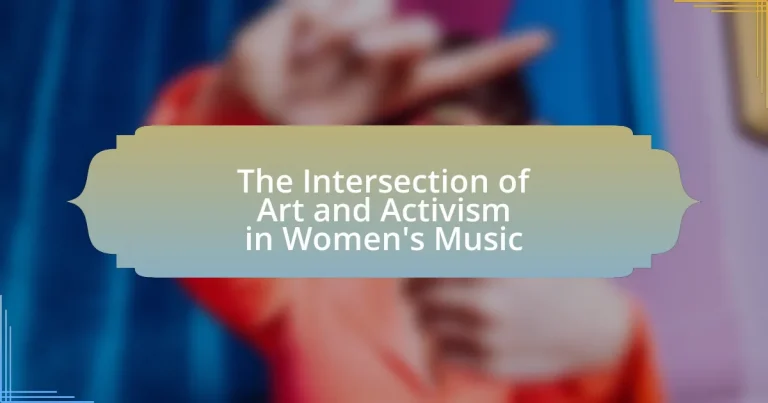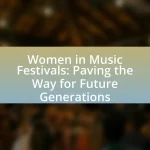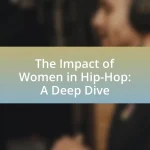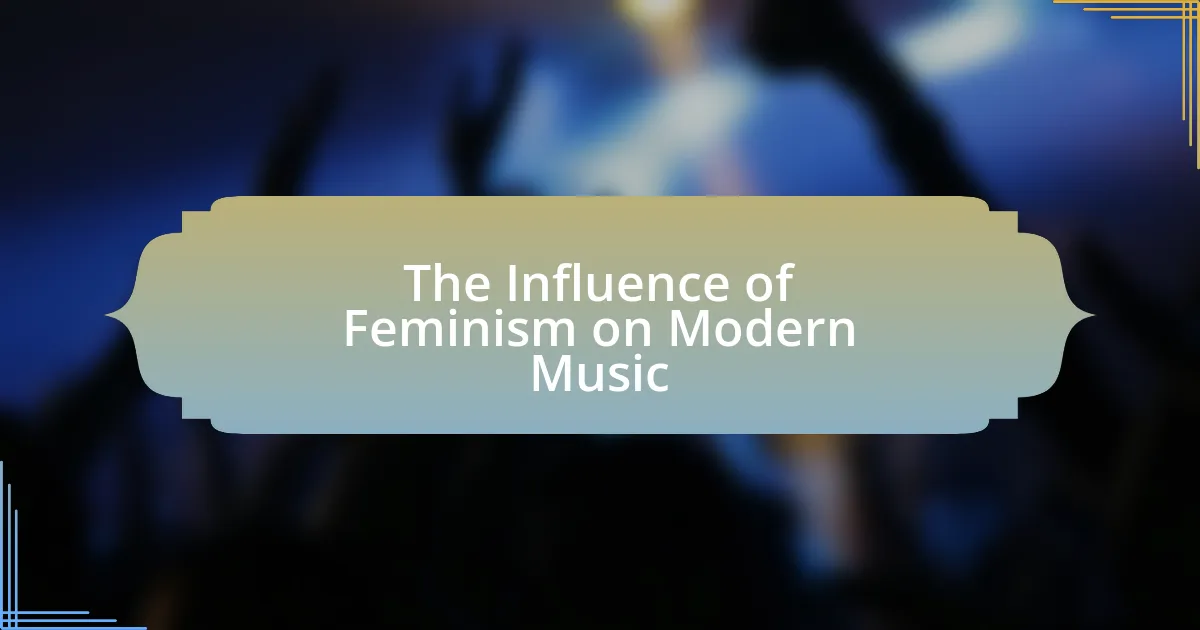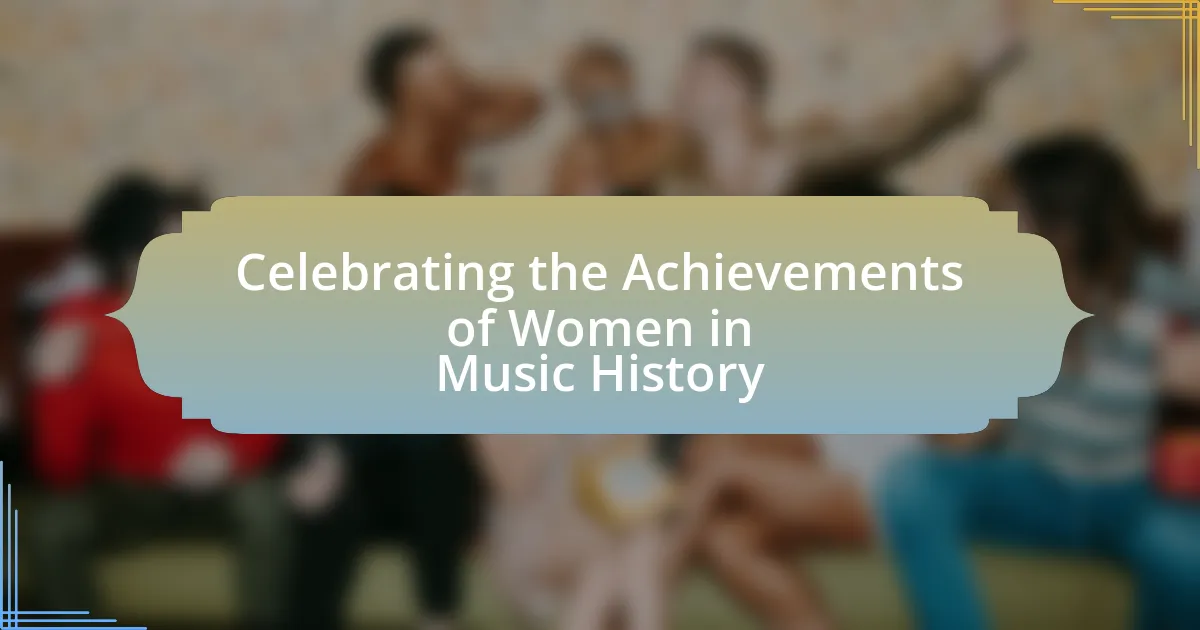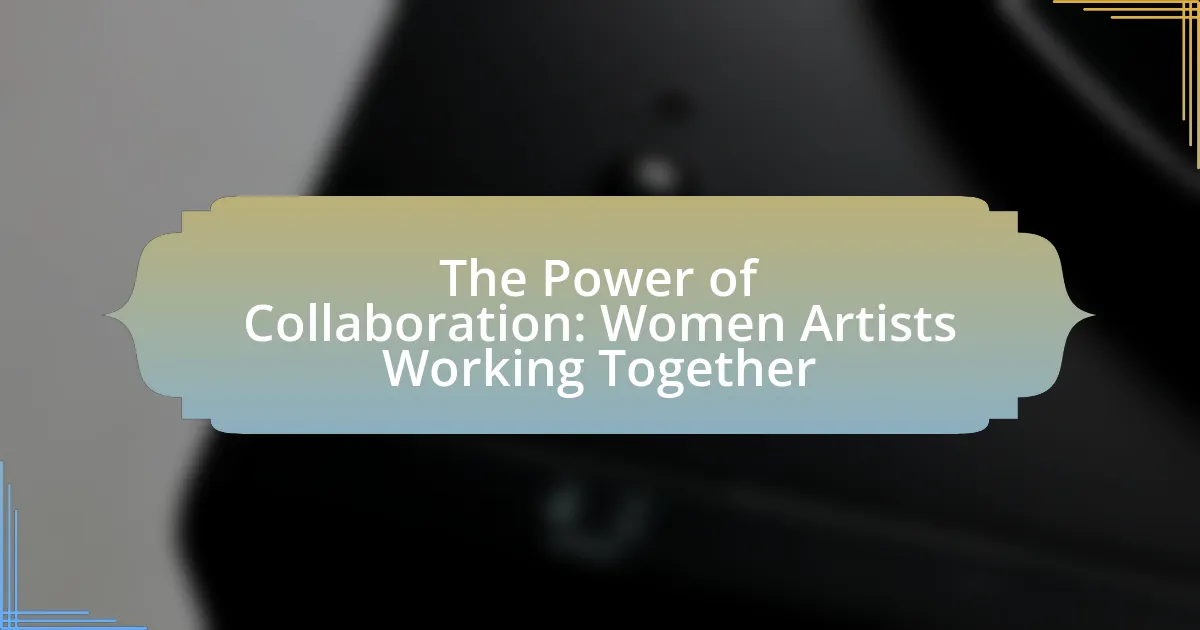The article explores the intersection of art and activism in women’s music, highlighting how female musicians use their work to address social issues, advocate for gender equality, and empower marginalized voices. It examines the historical intertwining of women’s music with activism, influenced by key movements such as feminism, civil rights, and LGBTQ+ rights. The article also discusses how female artists have utilized music as a form of protest, the significance of personal narratives, and the challenges they face in the industry. Additionally, it analyzes the impact of women’s music activism on societal change and the role of collaboration and resources in enhancing their efforts.
What is the Intersection of Art and Activism in Women’s Music?
The intersection of art and activism in women’s music is characterized by the use of musical expression to address social issues, advocate for gender equality, and empower marginalized voices. Women musicians often incorporate themes of feminism, social justice, and personal experiences into their work, creating a platform for activism. For example, artists like Joan Baez and Ani DiFranco have historically used their music to challenge societal norms and promote political change, demonstrating how music can serve as a powerful tool for activism. This relationship is evident in the rise of genres such as feminist punk and hip-hop, where lyrics often confront issues like sexism, violence, and inequality, thereby fostering community engagement and awareness.
How has women’s music historically intertwined with activism?
Women’s music has historically intertwined with activism by serving as a powerful medium for expressing social and political issues, particularly those affecting women and marginalized communities. For instance, during the women’s liberation movement of the 1960s and 1970s, artists like Joan Baez and Judy Collins used their music to advocate for gender equality and civil rights, creating anthems that resonated with activists. Additionally, the Riot Grrrl movement in the 1990s combined punk music with feminist activism, addressing issues such as sexual assault and body image through lyrics and performances. This connection between music and activism has been documented in various studies, highlighting how songs and performances have mobilized communities and fostered solidarity among women fighting for their rights.
What key movements have influenced this intersection?
Key movements that have influenced the intersection of art and activism in women’s music include the feminist movement, the civil rights movement, and the LGBTQ+ rights movement. The feminist movement, particularly in the 1960s and 1970s, emphasized women’s rights and empowerment, leading to the creation of music that addressed gender inequality and social justice. The civil rights movement inspired artists to incorporate themes of racial equality and justice into their work, fostering solidarity among women of diverse backgrounds. Additionally, the LGBTQ+ rights movement has played a crucial role in shaping women’s music, as many female artists have used their platforms to advocate for LGBTQ+ rights and representation, further intertwining activism with artistic expression.
How have female artists used music as a form of protest?
Female artists have used music as a form of protest by addressing social injustices, advocating for gender equality, and challenging oppressive systems through their lyrics and performances. For instance, artists like Nina Simone and Joan Baez utilized their music during the civil rights movement to highlight racial inequality and promote social change. In contemporary contexts, musicians such as Beyoncé and Billie Eilish have tackled issues like police brutality and mental health, respectively, using their platforms to raise awareness and inspire action. These artists often incorporate powerful imagery and messages in their music videos and live performances, further amplifying their protest messages and engaging audiences in critical conversations about societal issues.
Why is the intersection of art and activism significant in women’s music?
The intersection of art and activism is significant in women’s music because it empowers women to express their experiences and advocate for social change. This fusion allows female artists to address issues such as gender inequality, violence against women, and reproductive rights through their music, creating a platform for awareness and dialogue. For instance, artists like Ani DiFranco and Joan Baez have historically used their music to challenge societal norms and inspire activism, demonstrating how songs can mobilize communities and influence public opinion. This connection between artistic expression and activism not only amplifies women’s voices but also fosters solidarity and resilience within movements for gender justice.
What impact does this intersection have on societal change?
The intersection of art and activism in women’s music significantly influences societal change by amplifying marginalized voices and challenging systemic inequalities. This impact is evident in movements such as the Women’s Liberation Movement, where artists like Joan Baez and Ani DiFranco used their music to address issues like gender equality and reproductive rights, fostering awareness and inspiring action. Research indicates that music can mobilize communities, as seen in the 2017 Women’s March, where songs became anthems for social justice, illustrating how artistic expression can drive collective movements and reshape cultural narratives.
How does it empower women and marginalized voices?
Art and activism in women’s music empower women and marginalized voices by providing a platform for self-expression and social commentary. This empowerment occurs through the creation of music that addresses issues such as gender inequality, racial injustice, and LGBTQ+ rights, allowing artists to share their experiences and advocate for change. For instance, artists like Billie Holiday and Nina Simone used their music to highlight racial discrimination and civil rights, influencing public perception and inspiring movements. Additionally, organizations like Women in Music promote gender equality in the industry, further amplifying women’s voices and ensuring representation.
What are the key themes in women’s music activism?
Key themes in women’s music activism include empowerment, social justice, and representation. Empowerment is often expressed through lyrics and performances that encourage women to assert their rights and challenge societal norms. Social justice themes address issues such as gender inequality, violence against women, and LGBTQ+ rights, with artists using their platforms to raise awareness and advocate for change. Representation focuses on amplifying the voices of marginalized groups within the music industry, promoting diversity in genres and narratives. These themes are evident in movements like the Riot Grrrl movement of the 1990s, which combined punk music with feminist ideology, and contemporary initiatives like the #MeToo movement, where artists use their music to confront and discuss personal and collective experiences of harassment and discrimination.
How do themes of empowerment manifest in women’s music?
Themes of empowerment in women’s music manifest through lyrics that promote self-confidence, resilience, and social justice. Artists like Beyoncé and Lizzo use their platforms to challenge societal norms and advocate for body positivity and racial equality, exemplified in songs such as “Run the World (Girls)” and “Truth Hurts.” These tracks not only celebrate women’s strength but also inspire listeners to embrace their identities and fight against oppression. Research indicates that music can serve as a powerful tool for social change, with women’s music often reflecting and shaping feminist movements, thereby reinforcing the connection between art and activism.
What role does personal narrative play in these themes?
Personal narrative serves as a crucial mechanism for expressing individual experiences and emotions within the themes of art and activism in women’s music. By sharing personal stories, artists create a connection with their audience, fostering empathy and understanding around social issues such as gender inequality and identity. This connection is evidenced by the work of artists like Ani DiFranco and Joan Baez, who utilize their life experiences to highlight activism in their music, thereby inspiring collective action and awareness. Personal narratives not only enrich the artistic expression but also empower listeners to reflect on their own experiences, reinforcing the themes of solidarity and resistance in women’s music.
How do these themes resonate with broader social issues?
The themes in “The Intersection of Art and Activism in Women’s Music” resonate with broader social issues by highlighting gender inequality and advocating for women’s rights. Women’s music often addresses systemic oppression, reflecting societal struggles such as the fight for reproductive rights, equal pay, and representation in various sectors. For instance, the Women’s March in 2017 saw artists using their platforms to amplify messages of resistance against misogyny and discrimination, demonstrating how music serves as a vehicle for social change. This connection underscores the role of art in mobilizing communities and fostering dialogue around pressing social issues, thereby reinforcing the importance of activism within cultural expressions.
What are the challenges faced by women in music activism?
Women in music activism face several significant challenges, including gender discrimination, lack of representation, and limited access to resources. Gender discrimination manifests in various forms, such as unequal pay and fewer opportunities for women artists compared to their male counterparts. According to a 2020 report by the Annenberg Inclusion Initiative, women comprised only 21.6% of artists in popular music, highlighting the lack of representation in the industry. Additionally, women often encounter barriers in accessing funding and support for their projects, which can hinder their ability to promote social change through music. These challenges collectively impede women’s effectiveness and visibility in music activism.
How do societal norms impact women’s expression in music?
Societal norms significantly impact women’s expression in music by shaping the themes, styles, and visibility of their work. These norms often dictate what is considered acceptable or appropriate for women to express, leading to constraints on their artistic freedom. For instance, women may face pressure to conform to traditional gender roles, which can limit their exploration of diverse musical genres or controversial topics. Research indicates that female artists often encounter challenges such as sexism and objectification, which can hinder their ability to convey authentic messages in their music. A study by the Annenberg Inclusion Initiative found that only 22.4% of popular songs featured female artists, highlighting the systemic barriers that restrict women’s representation in the music industry. Thus, societal norms not only influence the content of women’s music but also affect their opportunities for recognition and success.
What barriers exist in the music industry for female activists?
Barriers in the music industry for female activists include systemic sexism, lack of representation, and limited access to funding and resources. Systemic sexism manifests in unequal opportunities for women compared to their male counterparts, as evidenced by the fact that women make up only about 20% of artists in popular music, according to a 2021 report by the Annenberg Inclusion Initiative. Additionally, female activists often face challenges in gaining visibility and support within a male-dominated industry, which can hinder their ability to promote social causes effectively. Limited access to funding further exacerbates these issues, as female-led projects receive significantly less investment than those led by males, impacting their ability to produce and distribute music that addresses activism.
How can we analyze the effectiveness of women’s music activism?
To analyze the effectiveness of women’s music activism, one can evaluate its impact through metrics such as audience engagement, social media reach, and changes in public discourse. Research indicates that women’s music activism has historically influenced social movements, as seen in the 1990s Riot Grrrl movement, which combined punk music with feminist messages, leading to increased awareness of gender issues in music and society. Additionally, studies show that songs addressing social justice themes can lead to measurable shifts in listener attitudes and behaviors, reinforcing the activism’s effectiveness. For instance, the song “I Will Survive” by Gloria Gaynor became an anthem for empowerment, illustrating how music can galvanize support for women’s rights.
What metrics can be used to measure the impact of women’s music on activism?
Metrics to measure the impact of women’s music on activism include social media engagement, concert attendance, and changes in public opinion. Social media engagement can be quantified through likes, shares, and comments on platforms where women’s music is promoted, indicating the reach and resonance of the message. Concert attendance figures provide insight into the mobilization of audiences around activist themes presented in women’s music. Changes in public opinion can be assessed through surveys conducted before and after significant music releases or events, revealing shifts in attitudes related to the issues addressed in the music. These metrics collectively demonstrate the effectiveness of women’s music in driving social change and raising awareness on critical issues.
How do audience engagement and reception play a role?
Audience engagement and reception significantly influence the impact of women’s music as a form of activism. Engaged audiences actively participate in discussions, share experiences, and amplify messages, thereby enhancing the reach and effectiveness of the artistic expression. For instance, studies show that when audiences resonate with the themes of empowerment and social justice in women’s music, they are more likely to mobilize for change, as evidenced by the increased attendance at events like the Women’s March, where music played a pivotal role in uniting participants. This interaction not only validates the artists’ messages but also fosters a community that supports ongoing activism, demonstrating the critical role of audience dynamics in shaping the discourse around women’s rights and social issues.
What examples illustrate successful outcomes of this activism?
Successful outcomes of activism in women’s music include the establishment of organizations like the Women’s Music Festival, which has provided a platform for female artists since 1974, promoting visibility and representation in the music industry. Additionally, the #MeToo movement, which gained momentum in 2017, has led to significant changes in how sexual harassment is addressed within the music industry, resulting in increased awareness and policy reforms. These examples demonstrate how activism has effectively influenced both cultural and structural changes in the music landscape for women.
What are some notable examples of women’s music activism today?
Notable examples of women’s music activism today include the #MeToo movement in music, which has seen artists like Kesha and Taylor Swift advocate against sexual harassment and assault in the industry. Additionally, the organization Women in Music promotes gender equality and supports female artists through initiatives and events. Furthermore, the all-female band The Chicks has used their platform to address social issues, including racism and women’s rights, particularly in their song “March March,” which highlights various social justice movements. These examples illustrate how women in music are actively engaging in activism to promote change and raise awareness on critical issues.
Which contemporary artists are leading this movement?
Contemporary artists leading the movement at the intersection of art and activism in women’s music include Billie Eilish, Janelle Monáe, and Lizzo. Billie Eilish uses her platform to address mental health and body image issues, often incorporating these themes into her music and visuals. Janelle Monáe advocates for LGBTQ+ rights and racial equality through her work, blending music with powerful social messages. Lizzo promotes body positivity and self-love, using her music to challenge societal norms around beauty and self-acceptance. These artists exemplify how music can serve as a vehicle for activism, influencing cultural conversations and inspiring change.
How are social media and technology influencing women’s music activism?
Social media and technology are significantly enhancing women’s music activism by providing platforms for visibility, community building, and direct engagement with audiences. These digital tools enable women musicians to share their messages, collaborate across geographical boundaries, and mobilize support for social causes. For instance, campaigns like #MeToo and #TimesUp have utilized social media to amplify women’s voices in the music industry, leading to increased awareness and action against sexual harassment. Additionally, streaming services and social media platforms allow women artists to reach wider audiences without traditional gatekeeping, fostering a more inclusive environment for diverse musical expressions and activism.
What practical steps can artists take to merge art and activism effectively?
Artists can merge art and activism effectively by creating works that address social issues, collaborating with activist organizations, and engaging their audiences in meaningful dialogue. By focusing on themes such as gender equality, environmental justice, or human rights, artists can use their platforms to raise awareness and inspire action. Collaborations with organizations like Amnesty International or local grassroots movements can amplify their message and reach broader audiences. Engaging audiences through interactive performances or community workshops fosters a deeper connection and encourages participation in activism. Historical examples include the Women’s Music Movement of the 1970s, where artists like Holly Near and Meg Christian used their music to advocate for women’s rights and LGBTQ+ issues, demonstrating the powerful impact of merging art with activism.
How can collaboration enhance the impact of women’s music activism?
Collaboration can enhance the impact of women’s music activism by amplifying diverse voices and creating a unified front against social injustices. When women musicians collaborate, they combine their unique perspectives and experiences, which can lead to more powerful and resonant messages in their music. For instance, collaborations can result in songs that address multiple facets of women’s issues, such as gender inequality, violence, and representation, thereby reaching a broader audience. Research shows that collective efforts in activism, such as the #MeToo movement, have significantly increased awareness and engagement around women’s rights, demonstrating that collaborative initiatives can lead to tangible societal change.
What resources are available for women artists engaged in activism?
Women artists engaged in activism have access to various resources, including grants, mentorship programs, and networks specifically designed to support their work. Organizations such as the Women’s Art Registry and the National Organization for Women provide funding opportunities and platforms for visibility. Additionally, initiatives like the Art for Justice Fund focus on social justice issues, offering financial support for projects that address systemic inequalities. These resources are crucial for empowering women artists to create impactful work that intersects with activism.
